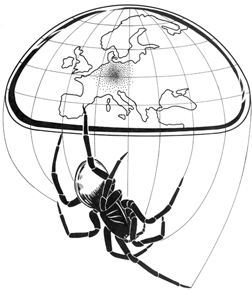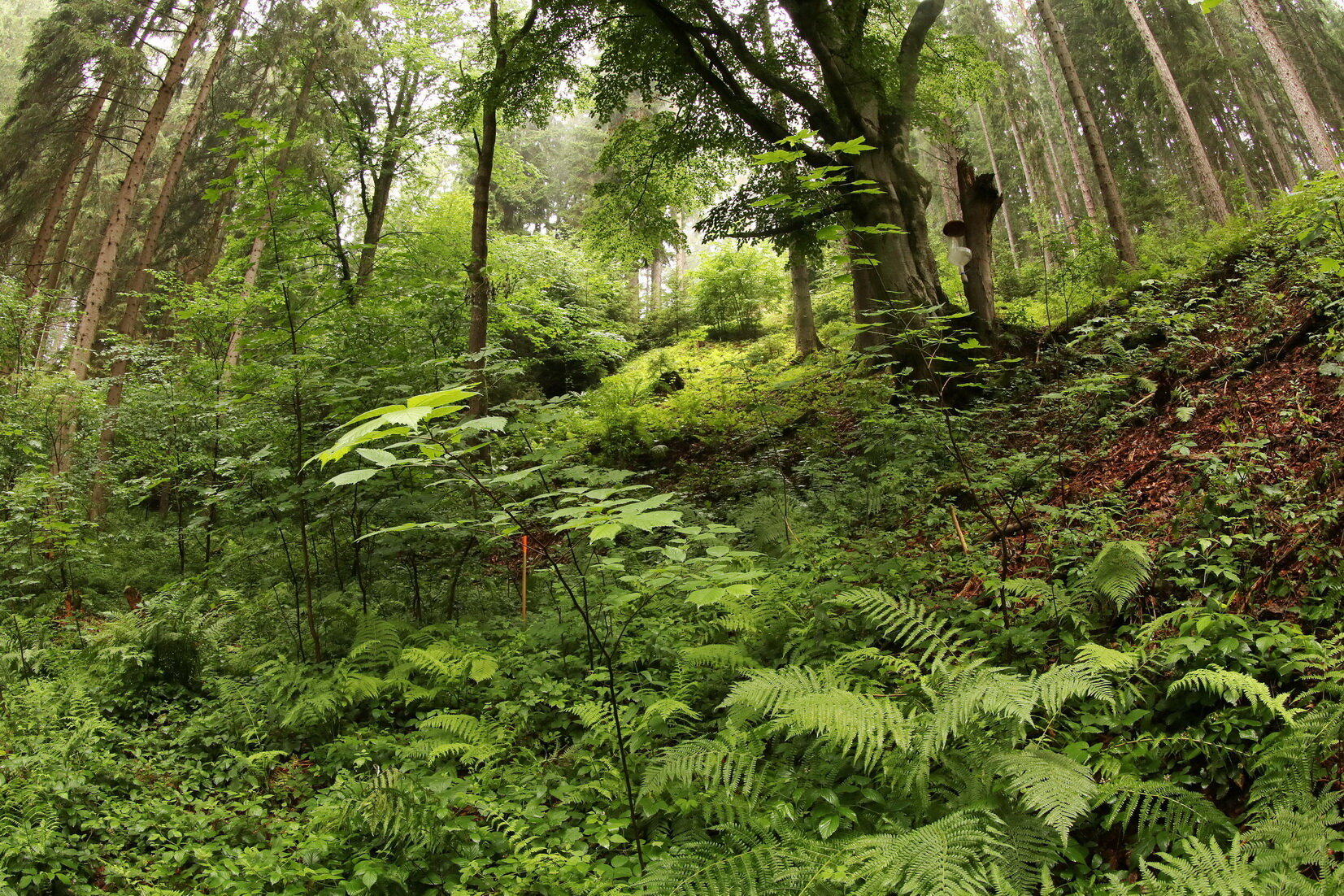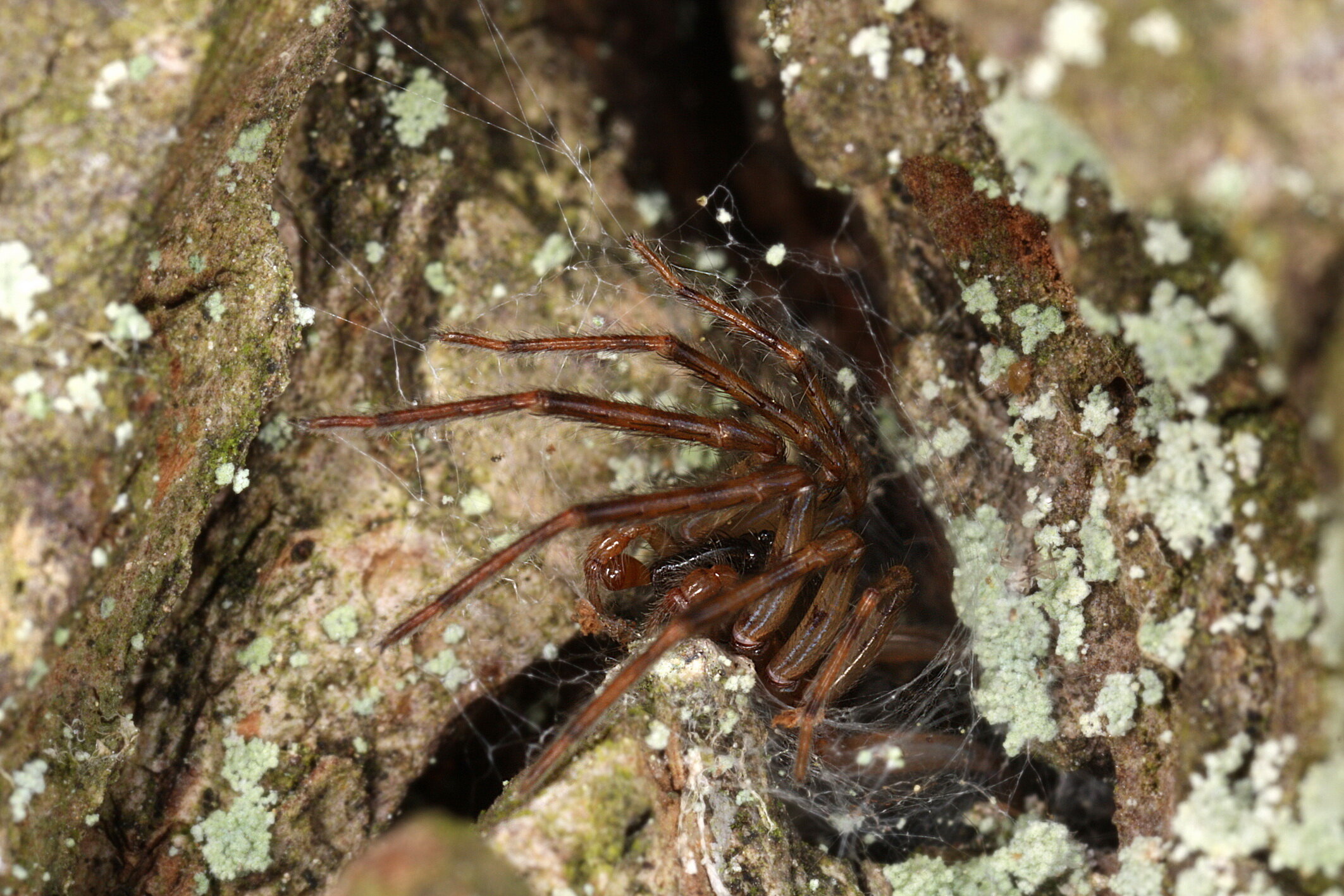Spider of the Year 2025
The Snake-back spider Segestria senoculata (Linnaeus, 1758)
The snake-back spider, Segestria senoculata (Linnaeus, 1758), belongs to the family of tube-dwelling spiders (Segestriidae). This spider family consists of five genera with 181 species worldwide. The genus Segestria includes 22 species, eight of which also occur in Europe.
The snake-back spider has a Palearctic distribution and occurs throughout Europe. The altitude distribution ranges from the planar to hilly elevations (up to 800 m above sea level) up to the tree line at approx. 2200 m altitude (in the Central Alps). Segestria senoculata lives in forests and in log and rubble heaps. Due to its abundance and the high availability of suitable habitats, it is classified as not endangered in the Red Lists.
Text: Christoph Hörweg & Norbert Milasowszky
Description
The body length of Segestria senoculata is 7-10 mm for females, while males are slightly smaller at 6-9 mm. Both sexes are similar in colouration and markings. The cephalothorax is shiny brown, the oval abdomen is pale beige/grey, dorsally with a dark brown, lobed and laterally bookended median band. This band resembles the dark pattern of an adder and is thus the source of the English common name: snake-back spider. The legs are light brown and have dark annulations. Most species of spiders have eight eyes, but tube-dwelling spiders only have six, which are arranged in three groups of two eyes each and form a rough "H" shape when viewed from above.
Way of life
Like all tube-dwelling spiders, the snake-back spider is predominantly nocturnal and builds a characteristic web to catch its prey. This consists of a mesh-like tube built into cracks and crevices (under tree bark, between stones, etc.) from which individual silk threads radiate out from the front entrance of the living tube. These strands act as tripwires for passing prey (especially insects) and transmit corresponding vibrations.
After dark, Segestria senoculata moves up to the entrance of the living tube, where it lies in wait for prey. It shows a leg position that is characteristic of all fishing web spiders: the first three pairs of legs are directed forward together and the fourth pair of legs are directed backwards. No other spiders show such a leg position!
During the mating season, males leave their living tubes to search for females. Sexually mature individuals of the snake-back spider can be found all year round. When a male which is ready to mate encounters a female's web, it shakes her signal threads. If the female does not react aggressively, mating occurs during which the male clutches the female's abdomen with his jaws spread wide apart.
After mating, the eggs are fertilized by the female in the living tube and encased in an oval cocoon; this contains between 60 and 180 eggs. The snake-back spider, like its two Central European sister species, needs around two years to reach sexual maturity.
Similar species
Two other Segestria species occur in Central Europe: the Bavarian tube-dwelling spider, Segestria bavarica, which is slightly larger (up to 14 mm) and whose dark spots on the abdomen are not continuous, and the green-fanged tube web-dwelling spider, Segestria florentina, which can grow up to 22 mm long and has a completely black body.
Text: Christoph Hörweg & Norbert Milasowszky
With this species, a representative of the tube-dwelling spiders Segestriidae could be introduced for the first time and it reveals some peculiar features: six eyes instead of eight, a characteristic web type, and a unique leg position!
By choosing the spider of the year, the aim is not only to put a "less popular" group of animals in a good light and to highlight threatened habitats - in this case, small natural habitats such as cracks and holes in tree bark and rocks - but at the same time scientists hope to acquire data on its current distribution. With this in mind: keep your eyes open on your next walk in the forest or on your next hike in the mountains and help document this species with your discovery report/photo.
The Spider of the Year is coordinated by the Natural History Museum Vienna, in collaboration with the Arachnologische Gesellschaft (AraGes) and the European Society of Arachnology (ESA).
Text: Christoph Hörweg & Norbert Milasowszky
Countries involved
Albania, Austria, Belgium, Bulgaria, Croatia, Czech Republic, Denmark, Finland, France, Germany, Great Britain, Hungary, Ireland, Italy, Liechtenstein, Luxembourg, Macedonia, The Netherlands, Norway, Poland, Portugal, Serbia, Slovakia, Slovenia, Spain, Sweden, Switzerland
Supporting societies
- ARABEL - Belgische Arachnologische Vereniging
- ARAGES - Arachnologische Gesellschaft
- BAS - The British Arachnological Society
- CAS - Česká arachnologická společnost
- ESA - European Society of Arachnology
- GIA - Grupo Ibérico de Aracnología
- NATURDATA - Biodiversidade online (Portugal)
Contact for Europe
Dr. Milan Řezáč
Biodiversity Lab, Crop Research Institute
Drnovská 507
161 06 Praha 6 – Ruzyně
Czech Republic
reza(a)cvurv.cz
Distribution in Europe
- Verbreitung nach araneae Spinnen Europas
- in Austria
- in Benelux
- in Czech Republic
- in Germany
- in Italy
- in der Switzerland
- in France
Wikis and Photo galeries
- Wiki of Spinnen-Forum (AraGes)
- Wikimedia commons
- araneae - spiders of Europe
- Pierre Ogers Galerie Arachno (Les araignées de Belgique e de France)
- Arachnologische Gesellschaft e.V. 2024 Atlas der Spinnentiere Europas (Arachnida: Araneae, Opiliones, Pseudoscorpiones, Amblypygi, Solifugae, Scorpiones, Schizomida) für Segestria senoculata – (link) (29.11.2024)
- Arachnologische Gesellschaft e.V. 2024 Wiki des Spinnen-Forums – (link) (29.11.2024)
- Bellmann H 2016 Der Kosmos Spinnenführer. Frackh-Kosmos Stuttgart. 429 pp.
- Blick T, Bosmans R, Buchar J, Gajdoš P, Hänggi A, Helsdingen P van, Růžička V, Staręga W & Thaler K 2004 Checkliste der Spinnen Mitteleuropas. Checklist of the spiders of Central Europe. (Arachnida: Araneae). Version 1. Dezember 2004
- Blick T, Finch O-D, Harms KH, Kiechle J, Kielhorn K-H, Kreuels M, Malten A, Martin D, Muster C, Nährig D, Platen R, Rödel I, Scheidler M, Staudt A, Stumpf H & Tolke D 2016 Rote Liste und Gesamtartenliste der Spinnen (Arachnida: Araneae) Deutschlands. – In: Gruttke H, Balzer S, Binot-Hafke M, Haupt H, Hofbauer N, Ludwig G, Matzke-Hajek G & Ries M [Red.] Rote Liste gefährdeter Tiere, Pflanzen und Pilze Deutschlands, Band 4: Wirbellose Tiere (Teil 2). – Münster (Landwirtschaftsverlag). – Naturschutz und Biologische Vielfalt 70(4):383-510
- Breitling R, Merches E, Muster C, Duske K, Grabolle A, Hohner M, Komposch C, Lemke M, Schäfer M & Blick T 2020 Liste der Populärnamen der Spinnen Deutschlands (Araneae) – Arachnologische Mitteilungen 59:38-60. doi: 10.30963/aramit5907
- British Arachnological Society 2024 Factsheet 9. The tube spiders. – (link) (29.11.2024)
- CSCF (Centre Suisse de Cartographie de la Faune) 2019 Fauna der Schweiz – Spinnentiere oder Arachniden (Skorpione, Pseudoskorpione, Spinnen, Weberknechte, Milben) – (link) bzw. Verbreitungskarte für Segestria senoculata: (link) (29.11.2024)
- Hänggi A, Stöckli E & Nentwig W 1995 Lebensräume mitteleuropäischer Spinnen. Charakterisierung der Lebensräume der häufigsten Spinnenarten Mitteleuropas und der mit diesen vergesellschafteten Arten – Miscellanea Faunistica Helvetiae 4:1-459
- Hörweg C & Milasowszky N 2025 Die Gewöhnliche Fischernetzspinne Segestria senoculata (Linnaeus, 1758): Spinne des Jahres 2025 - in Lauerstellung unter Baumrinde und in Felsspalten. - Entomologica Austriaca 32: 55–64
- Jocqué R & Dippenaar-Schoeman AS 2006S pider families of the world. Musée Royal de l'Afrique Central Tervuren, 336 pp.
- Komposch C 2023 Spinnen (Arachnida: Araneae) – In: Komposch C (Hrsg): Rote Liste gefährdeter Tiere Kärntens. – Verlag des Naturwissenschaftlichen Vereins für Kärnten, Klagenfurt am Wörthersee, pp. 481-568
- Nentwig W, Ansorg J, Cushing P, Kranz-Baltensperger Y, Kropf C. 2024 Fischernetzspinnen (Segestriidae). In: Hausspinnen weltweit. Springer, Berlin, Heidelberg, pp.173-176. doi: 10.1007/978-3-662-68850-2_21
- Nentwig W, Blick T, Bosmans R, Gloor D, Hänggi A & Kropf C 2022 araneae – Spiders of Europe, version 12.2024 – (link) (02.12.2024). doi: 10.24436/1
- Reichholf JH & Steinbach G 1997 Die grosse Enzyklopädie der Insekten, Spinnenund Krebstiere, Band 1. Bertelsmann Lexikon Verlag Gütersloh. 360 pp.
- Thaler K & Knoflach B 2002 Zur Faunistik der Spinnen (Araneae) von Österreich: Atypidae, Haplogynae, Eresidae, Zodariidae, Mimetidae. Linzer Biologische Beiträge 34:413-444
- World Spider Catalog 2024 World Spider Catalog, version 25.5. Natural History Museum Bern – (link) (02.12.2024)








